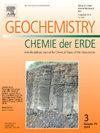阿尔及利亚南部Silet地体中与造山带金矿相关的电气石:热液结晶过程中组成和氧化还原状态的演化
IF 2.9
3区 地球科学
Q2 GEOCHEMISTRY & GEOPHYSICS
引用次数: 0
摘要
在Silet地体(阿尔及利亚南部Hoggar西部),金与石英脉中的电气石伴生。在asouf melen、Seldrar和Idreksi矿床中,含金矿脉切割了造山前tonalite - trondhjemite -花岗闪长岩群(868-840 Ma)的闪长岩和花岗闪长岩杂岩。这些脉体主要走向N-S、NE-SW和NW-SE方向,并优先发育在4°30′主断裂带(Iskel剪切带)外的次级NE-SW和NW-SE断裂交汇带。游离金以包裹体的形式浸染在石英和碧玺中,以裂隙充填形式存在于变形的碧玺晶体中。在黄铜矿和氧化铁中也发现了金的包裹体。从矿物化学特征看,电气石属碱类,为榴辉岩系列和富辉岩-氧辉岩系列,具有向正/钾云母岩演化的趋势;钙族中的电气石成分(菱钙石、镁菱钙石)只是少量的。Silet中的电气石可能形成贫Al富Fe3+晶石(Tur I),然后再结晶(Tur II),富集Mg和Al, x位空位较高(富Mg晶石→富fe晶石)。Seldrar产状(Silet地块中部)中,金与初始Fe3+含量高的电气石(Tur I)伴生,而后期Tur II的组合则为贫矿。矿化石英脉形成后期的氧化条件使富Fe3+矿物向富Fe3+矿物方向演化。低温风化作用使部分金重新赋存。本文章由计算机程序翻译,如有差异,请以英文原文为准。
Tourmaline associated with orogenic gold occurrences in the Silet terrane, South Algeria: Evolution of composition and redox state during hydrothermal crystallization
In the Silet terrane (western Hoggar, southern Algeria), gold occurs in association with tourmaline in quartz veins. In the Assouf Mellen, Seldrar, and Idreksi occurrences, gold-bearing veins cut diorite and granodiorite complexes of the pre-orogenic Tonalite-Trondhjemite-Granodiorite group (868–840 Ma). These veins trend dominantly in the N-S, NE-SW, and NW-SE directions, and are preferentially developed at the intersection zones of secondary NE-SW and NW-SE fault splays off the main 4°30′ fault zone (Iskel Shear Zone). Free gold is present as inclusions disseminated in quartz and tourmaline, and as fissure-fillings in deformed tourmaline crystals. Gold was also found as inclusions in chalcopyrite and in iron oxides.
Based on the mineral chemistry, the tourmaline belongs to the alkali group and represents the schorl–dravite and foitite–oxy-foitite series and shows evolution trends to bosiite/povondraite; tourmaline components from the calcic group (lucchesiite, magnesio-lucchesiite) are minor only. Tourmaline in Silet was likely formed as Al-deficient Fe3+-enriched schorl (Tur I), later recrystallized (Tur II) and enriched in Mg and Al with higher X-site vacancy (Mg-rich schorl to Fe-rich dravite). In the Seldrar occurrences (middle part of Silet terrane), gold is associated with tourmaline with high initial Fe3+-contents (Tur I) while the assemblage of the later Tur II is barren. The evolution towards Fe3+-rich schorl may be explained as a result of more oxidizing conditions in the late stage of formation of the mineralized quartz veins. Part of gold was remobilized by low-temperature weathering processes.
求助全文
通过发布文献求助,成功后即可免费获取论文全文。
去求助
来源期刊

Chemie Der Erde-Geochemistry
地学-地球化学与地球物理
CiteScore
7.10
自引率
0.00%
发文量
40
审稿时长
3.0 months
期刊介绍:
GEOCHEMISTRY was founded as Chemie der Erde 1914 in Jena, and, hence, is one of the oldest journals for geochemistry-related topics.
GEOCHEMISTRY (formerly Chemie der Erde / Geochemistry) publishes original research papers, short communications, reviews of selected topics, and high-class invited review articles addressed at broad geosciences audience. Publications dealing with interdisciplinary questions are particularly welcome. Young scientists are especially encouraged to submit their work. Contributions will be published exclusively in English. The journal, through very personalized consultation and its worldwide distribution, offers entry into the world of international scientific communication, and promotes interdisciplinary discussion on chemical problems in a broad spectrum of geosciences.
The following topics are covered by the expertise of the members of the editorial board (see below):
-cosmochemistry, meteoritics-
igneous, metamorphic, and sedimentary petrology-
volcanology-
low & high temperature geochemistry-
experimental - theoretical - field related studies-
mineralogy - crystallography-
environmental geosciences-
archaeometry
 求助内容:
求助内容: 应助结果提醒方式:
应助结果提醒方式:


